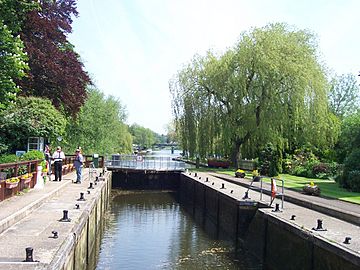Shiplake Lock facts for kids

Shiplake lock looking downstream with Shiplake Railway Bridge in the distance
|
|
| Waterway | River Thames |
|---|---|
| County | Oxfordshire |
| Maintained by | Environment Agency |
| Operation | Hydraulic |
| First built | 1773 |
| Latest built | 1874 |
| Length | 40.64 m (133 ft 4 in) |
| Width | 5.56 m (18 ft 3 in) |
| Fall | 1.55 m (5 ft 1 in) |
| Above sea level | 110' |
| Distance to Teddington Lock |
49 miles |
Shiplake Lock is a special water gate, called a lock, and a small dam, known as a weir. They are found on the River Thames in England. This spot is between the villages of Shiplake and Lower Shiplake in Oxfordshire.
The lock is just above where the River Loddon joins the Thames. It's also near the Shiplake Railway Bridge, which crosses the river. The first lock here was built a long time ago in 1773. The weir is a bit further upstream from the lock. It sits between the lock island and the river bank in Berkshire.
Contents
The Story of Shiplake Lock
Early Days and Changes
People knew about a weir and a simple type of lock, called a flash lock, here in the 1500s. It was then known as "Cotterell's." This name stuck even after a more modern pound lock was built.
Shiplake Lock was one of the first locks built after a new law about river travel in 1770. It was finished in 1773, made from fir wood. Sadly, the fir wood rotted quickly. So, the lock had to be rebuilt with stronger oak wood in 1787.
Mills and Modern Updates
At that time, there were two mills on the island next to the lock. The lock was rebuilt again in 1874, and the weir was fixed in 1885. In 1891, the City of London Corporation bought the lock island. They wanted to use it for camping. The old, ruined mills were taken down in 1907.
Shiplake Lock was the very first lock on the River Thames to get a modern hydraulic system. This happened in 1961, making it easier to open and close the gates. More recently, in 2009 and 2010, the old wooden lock gates were replaced. New, strong steel gates were put in place. This big upgrade cost about £600,000.
Camping at Shiplake Lock Island
A Place for Fun and Relaxation
The City of London Corporation bought Shiplake Lock Island for a good reason. They wanted to keep it as a nice place for swimming and camping. At first, they managed the island from far away. This was a bit tricky.
So, in 1914, they gave the island to the Thames Conservancy to manage forever. The camping area was then divided into 18 smaller plots. The people who looked after the lock also helped run the camp.
Rules and Community
Soon after taking over, the Conservancy allowed small huts to be built. These huts were only for cooking, not for sleeping. Back then, women were not allowed to sleep on the island. They had to stay in wooden huts on the nearby Shiplake bank.
The groups that have managed the river, like the Thames Conservancy and later the Environment Agency, usually give out one-year leases for the camping plots. Even with short leases, the camping community has stayed very strong. Many plots have been passed down through families for generations.
Finding Shiplake Lock
Paths to the River
You can get to Shiplake Lock from the village of Lower Shiplake. Just follow Mill Road, then Mill Lane. There's a paved path that leads right to the lock.
You can also reach it from the village of Shiplake itself. From Shiplake Church, take the chalky path down to the riverbank. You'll walk past the boathouse of Shiplake College. The path then goes under the College buildings and past Shiplake House. The lock is just a few hundred meters along this part of the Thames Path.
The River Above Shiplake Lock
Islands and Streams
As the river flows above Shiplake Lock, it goes past Shiplake village on the Oxfordshire bank. Eventually, it reaches Sonning. Just above the lock, you'll see Phillimore Island. On the hill nearby are Shiplake House and Shiplake Court, which is now Shiplake College. The college's boathouse is right on the river.
Further along, the river makes two big bends. Here, you'll find two large islands: The Lynch and Hallsmead Ait. After these, there's another island called Buck Ait. On the bank opposite Buck Ait is St Patrick's Stream. People believe this stream was once part of the River Loddon. It became an outflow when the water level rose after Shiplake Lock was built.
Nature and Bridges
Except for a small group of buildings here, the river banks are mostly open fields all the way to Sonning Bridge. Sonning Lock is a short distance upstream from the bridge. Before the bridge, there's a large side channel of the river on the Sonning Eye side. This channel is crossed by several bridges known as Sonning Backwater Bridges.
Walking the Thames Path
The Thames Path is a long-distance walking trail. It stays on the Oxfordshire bank of the river as it goes towards Sonning. Once it reaches Sonning, the path crosses the bridge to the other side of the river. From there, it continues on to Sonning Lock.
Shiplake Lock in Books
Shiplake Lock was a special place for fishing for the famous writer George Orwell when he was young. He often fished there with his friends, including Jacintha Buddicom.

